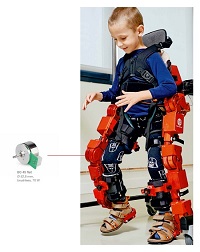Design considerations for exoskeletons for children
Developing Exoskeletons for children present their own engineering challenges simply because children are still growing.
Exoskeletons were largely developed for people that have sustained paralysis or suffer muscular dystrophy. For adults who have stopped growing there is no risk of outgrowing the exoskeleton. However for children their growth and ability present a multitude of challenges for design engineers.
An exoskeleton that fits a six-year old perfectly may be much too small by the time the child turns seven. For a child with spinal muscular atrophy an exoskeleton is designed to recognise users are not completely paralysed but are able to move their legs to a certain extent. Sensors within the frame detect weak leg movements and respond immediately to provide support. As a result, the child is able control the exoskeleton directly with the legs. Spanish company, Marsi Bionics, manufactures exoskeletons mainly for adults but have developed two exoskeletons for children, the Atlas 2020 and Atlas 2030. Weighing approximately 14 kgs it is made for children from 3 years up who have a neuromuscular disease. The exoskeleton can be adapted to various leg lengths and hip widths, so that it also fits teenagers up to about 14 years of age. The “Atlas 2030 is an upgrade of Atlas 2020”, explains Elena García, creator and co-founder of Marsi Bionics. “The main difference is that Atlas 2020 is intended for use in hospitals for gait training and rehabilitation, while Atlas 2030 is designed for use in private homes as an integral part of the patient's everyday life. Both devices are ready for industrial production and until then, Atlas 2020 will continue to be used in hospitals for clinical research.” maxon motor have five drive systems in each leg of the children’s exoskeleton. Brushless flat EC45 motors deliver very high torque in a compact design, coupled with inductive MILE encoders that act as sensors. The motors are controlled by servo controllers from maxon's ESCON series. “EC flat motors provide the best power-to-weight and power-to-volume ratio”, explained Elena García. “This is a variable of paramount importance, as gait exoskeletons require high power but a very low weight and volume.” The exoskeletons will be made available commercially once CE certification marks have been received. For more information contact maxon motor UK Tel. +44 (0)1189 733337
© 2018 by maxon motor Austrailia
Back to the news overview